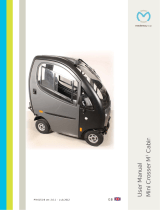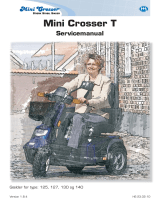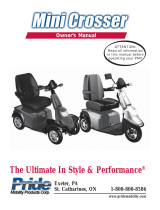medemagroup Mini Crosser M User manual
- Category
- Scooters
- Type
- User manual
This manual is also suitable for

P9-0155-Q ver. 2.0.3 - September 2013 GB
Quick guide
Mini Crosser M1
medemagroup

Quick guide P9-0155-Q 2 of 16 Version 2.0.3/2013
Medema Production A/S

Quick guide P9-0155-Q 3 of 16 Version 2.0.3/2013
Medema Production A/S
Contents
Quick guide to the Mini Crosser M1 ........................................................4
Introduction ................................................................................................4
Control panel .............................................................................................5
Seat rotation ...............................................................................................7
Steering column ........................................................................................8
Charging .....................................................................................................9
Battery indicator ......................................................................................10
Serial number...........................................................................................12
Driving the Mini Crosser M1 ...................................................................12
Getting in and out .................................................................................12
When driving in traffi c... ........................................................................14
Electromagnetic compatibility ...............................................................14
Braking systems ......................................................................................15

Quick guide P9-0155-Q 4 of 16 Version 2.0.3/2013
Medema Production A/S
Quick guide to the Mini Crosser M1
Introduction
Congratulations on your new Mini Crosser M1 electric mobility scooter.
You have now taken possession of an electric mobility scooter developed
for outdoor driving by active users. It is what is called a Class C vehicle in
accordance with the European classifi cation of electric scooters.
For optimum enjoyment of this vehicle - and to avoid breakdowns and
accidents - we recommend that you read the User Manual carefully. As a
new user, you should pay particular attention to the section entitled “Driving
the Mini Crosser M1”.
Note:
This Quick Guide is to be regarded as a supplement to the User Manual.
The information in the Quick Guide cannot, therefore, be expected to be
complete.
NB: Errors and omissions excepted. Specifi cations subject to change.
We reserve the right to update this guide as required.
Warning!
The vehicle must not be lent to persons who are not completely familiar
with it.
The vehicle is designed for one person only.
Max. user weight 175 kg. Can be supplied in a HD version as standard for a
max person weight of 250 kg.
Medema Production A/S is not responsible for any damage or injuries
caused by inappropriate or unsafe use of the Mini Crosser.

Quick guide P9-0155-Q 5 of 16 Version 2.0.3/2013
Medema Production A/S
Control panel
Avoid subjecting the control panel to jarring and knocks. Take care when
driving and avoid hitting obstacles.
Indicator lights,
R/L
Horn
Battery indicator
Handbrake
Light switch
Indicator lights, R/L
Horn
Accelerator
(four-fi nger control)
Speed selector
Hazard warning lights
Lever for adjusting the angle of the
handlebars
Charging socket
Key switch

Quick guide P9-0155-Q 6 of 16 Version 2.0.3/2013
Medema Production A/S
Designation Description
Key switch To start the vehicle:
Turn the key to driving position (1) When the Mini Crosser is turned on,
the control system performs a safety check of the electrical system.
The check lasts half a second. If the accelerator is operated during this
time, the Mini Crosser will not be able to move until you have turned
the key to 0 and back to 1.
Speed selector The tortoise in minimum position indicates the lowest speed range.
0-6 km/h
The hare in maximum position indicates the highest speed range.
Up to 15 km/h
Battery indicator Lights up when the key is turned. Indicates, after half a second, the
battery charge level. It gives a more precise indication after approx.
1 minute of driving. When the red, amber and green sections are lit,
the batteries are fully charged. When the indicator is at the bottom
of the amber section, the batteries should be charged as soon as
possible. If only the red section is lit or fl ashing, the batteries must
be charged immediately.
Handbrake Acts on the rear wheel and should only be used as an extra /
emergency brake and parking brake. It can be secured in locked
position. Also available as a foot brake.
Accelerator Activate the arm at the front slowly and the Mini Crosser will start
to move forwards. The more the arm is pressed, the faster the Mini
Crosser will move. When the arm is released, it will fl ip back to
starting position of its own accord and the Mini Crosser will stop.
Activating the rear arm will cause the Mini Crosser to reverse. The
magnetic brake on the rear wheels will engage when the scooter
is stationary and is equivalent to the parking brake on a car. The
accelerator can also be used to control speed downhill. In this case
the motor will act as a brake.
Light switch Turns on the front and rear lights. The key switch must be in
position 1 (driving position).
Hazard warning
lights Turns on all the indicator lights at once. Also works when the key is
removed or turned to position 0 (stop position).
Indicator switch Left arrow: indicator, left-hand side. Right arrow: indicator, right-
hand side. Activate the same switch to turn the indicators off.
Horn Powerful electric horn. Press the horn switch to activate.
Charging socket Turn off the key switch during charging. Please note that it is not
possible to drive the scooter while the batteries are charging. See
also the section entitled “Batteries and charging”.

Quick guide P9-0155-Q 7 of 16 Version 2.0.3/2013
Medema Production A/S
Seat rotation
Pull the release lever back. The seat can be rotated 90° to either side.
When the lever is released, it engages with the seat and holds it in place at
45° intervals.
Other seats that can be supplied for the Mini Crosser work on similar
principles. The release lever is normally located on the right, but can be put
on the left if so wished.
IMPORTANT!
The Mini Crosser is most stable when the seat is in its lowest position.
Always drive carefully when the seat is raised. Never use the seat
adjustment when driving on an uneven surface or in hilly terrain.
Take extra care when lowering the seat on a Mini Crosser using electric
seat adjustment. Make sure that nothing is trapped in the space between
the seat and the chassis.
Release lever for seat rotation. Release lever for seat forward/back.

Quick guide P9-0155-Q 8 of 16 Version 2.0.3/2013
Medema Production A/S
Steering column
Can be adjusted forward/back with the release lever. Pull down on the lever
and pull the handlebars closer for a good driving position. Use the lever
again and push the steering column forward to make it easier to get out.
Adjusting the height of
the handlebars. Applies to
both the 3W and the 4W
model.
Lever for adjusting the angle of
the handlebars

Quick guide P9-0155-Q 9 of 16 Version 2.0.3/2013
Medema Production A/S
Charging
The Mini Crosser should be charged while not in use. The charger supplied
from the factory switches to trickle charging (very low power consumption)
automatically when the batteries are fully charged. You can therefore leave
the charger connected until the Mini Crosser is next used. The charger
cannot overcharge the batteries.
The charger will fl ash until charging is complete. Then it will show a steady
light.
IMPORTANT!
The charger must not be placed on the seat during charging.
IMPORTANT!
Never use charging devices other than those supplied from the factory
without fi rst contacting the dealer.
For further information see the User Manual.
NEUTRIK NC3MX charging plug Connect the charging plug to the 3-pin
socket on the steering column. The charging
socket is located under the protective cover.

Quick guide P9-0155-Q 10 of 16 Version 2.0.3/2013
Medema Production A/S
Battery indicator
If there is an electronic fault, a number of lamps in the battery indicator will
light up. The following table shows what they mean.
For further information on troubleshooting see the User Manual.
Lamps Causes Remedy
1 lamp The batteries need charging
or the connection to a battery
is poor.
Check all connections
between the controller and
batteries. If these are fi ne, try
charging the batteries
2 lamps Poor connection to the motor. Check the connection
between the motor and
controller. Contact supplier.
3 lamps Short-circuit between
the motor and a battery
connection.
Contact supplier - say how
many lamps are lit.
4 lamps Not in use
5 lamps Not in use
6 lamps The S180 is prevented
from driving. Inhibit 2 is
active. This may be due to
the battery charger being
connected, the plug to the
thermal switches being
disconnected, a fault in the
thermal switch or the scooter
is overheating.
The Mini Crosser will turn
itself off automatically after
it has been stationary for 10
minutes. The battery indicator
fl ashes with 6 lamps at a rate
of about 3 seconds.
Stop the unit and wait 3-5
minutes before restarting.
Turn the key to 0 and then to
1 to reset the fault.
Contact supplier.
To start M1 again, the key
must be turned to position 0
and back to I.
7 lamps Accelerator fault. Make sure that the
accelerator is in neutral when
the Mini Crosser is turned on.
8 lamps Controller fault. Contact supplier.

Quick guide P9-0155-Q 11 of 16 Version 2.0.3/2013
Medema Production A/S
Lamps Causes Remedy
9 lamps Poor connection to motor
brake.
Magnetic brake is
disengaged.
Check the connections from
brake to controller, or push
the brake lever up.
Check that the vehicle is not
disengaged.
10 lamps The controller has been
supplied with a high voltage
in excess of 38 V. Usually
seen in the case of a poor
connection.
Check all connections from
the batteries to the controller.
Running lights Charger is connected. Remove charger.

Quick guide P9-0155-Q 12 of 16 Version 2.0.3/2013
Medema Production A/S
Serial number
All vehicles have a serial number plate showing the year of production,
month and serial number. The same serial number can also be found on
the front of the User Manual.
Please quote the serial number when making inquiries about
servicing, spare parts, etc.
Driving the Mini Crosser M1
Getting in and out
It is important to learn a safe technique for getting in and out of the Mini
Crosser.
In general the following method should be followed:
• Make sure that the Mini Crosser M1 is off (switch turned to 0) when getting in
and out, otherwise the Mini Crosser could start if the accelerator was touched
inadvertently.
• Make sure that the brake is on. (Lever for disengaging motor in top position.)
• Put the steering column in vertical position.
• If necessary, turn the seat through 45° or 90° and make sure that it is locked in
position (clicked into place).
• If necessary, raise the armrest.
IMPORTANT!
The Mini Crosser will turn itself off automatically after it has been stationary
for 10 minutes even if the key has been turned to driving position.
To restart the vehicle, the key must be turned to stop position (0) and then
to drive position (1).

Quick guide P9-0155-Q 13 of 16 Version 2.0.3/2013
Medema Production A/S
General safety advice:
• Make sure that the backrest is upright and the seat is as low as possible.
• Positioning belts are recommended if the user is unable to maintain a good
driving posture independently.
• Adjust your driving to road conditions. Take account of light, traffi c and weather.
Be particularly careful when driving in the dark or in bad weather, such as rain
or snow. Avoid driving on gradients with poor surfaces, such as: snow, ice, new-
mown grass, wet grass and wet leaves.
• Never drive when under the infl uence. This applies not only to alcohol but also
to drugs and medicines.
• Reduce speed immediately if you feel you are losing control.
• Always use the indicators when changing direction.
• Check that lights and indicators are working before driving off. Use your lights
when driving after lighting-up time.
• As far as possible, grip the handlebars fi rmly with both hands.
Take care not to have anything in the basket at the front that might
inadvertently operate the accelerator.
WARNING! Do not lower the handlebars so far that the accelerator
can hit you on the leg when you turn the vehicle and so be operated in
advertently. If the handlebars need to be very low, a twist grip accelerator is
recommended. This is particularly relevant if leg supports are being used.
ALWAYS switch the scooter off when it is not in use. Turn the key to 0.
Note!
Do not drive the Mini Crosser when intoxicated. This applies to both
medicine and alcohol.

Quick guide P9-0155-Q 14 of 16 Version 2.0.3/2013
Medema Production A/S
When driving in traffi c...
Be particularly aware of the following when driving in traffi c:
• The Mini Crosser is a low vehicle and not always easy for other road users to
see. Make quite sure that other road users have seen you before driving onto
the highway.
• Keep an eye on traffi c behind you. Keep well over to the side of the road when
driving on busy roads.
• Turning right and left at crossroads. Be aware of cyclists and pedestrians.
Follow the rules of the road for cyclists.
• How quickly things are happening. How long do the lights stay green? How
quickly are cars approaching? etc.
Electromagnetic compatibility
If the Mini Crosser starts making involuntary movements or if the brakes
are released, turn the Mini Crosser off as soon as it is safe to do so. In
certain circumstances a Mini Crosser can set off shop alarms.
The Mini Crosser satisfi es the requirements for the use of scooters in an
environment with electromagnetic noise. There may, however, be rare
situations in which electromagnetic noise can affect the Mini Crosser.
Sources of such noise include radio and television stations, amateur radio
transmitters and mobile phones.
If such equipment is being used close by, it is recommended that the
Mini Crosser is switched off. Mobile phones should not be used while
driving.

Quick guide P9-0155-Q 15 of 16 Version 2.0.3/2013
Medema Production A/S
Braking systems
There are three braking systems on the Mini Crosser:
• Motor brake - adjusts vehicle speed also when going downhill.
• Magnetic brake - the magnetic brake is automatic and engages when the
Mini Crosser stops. In an emergency, the Mini Crosser can be stopped
instantaneously by turning the key switch. Please note that this will cause very
sharp braking. The rear wheels will lock.
Must NOT be used in the normal course of driving.
The brake must never be disengaged mechanically using the disengagement
lever on a slope. This function is only designed for use when pushing the Mini
Crosser on a fl at road.
• Electric safety brake - if the brake is somehow disengaged on a slope/hill, the Mini
Crosser will brake automatically when it reaches a certain speed. There is an electric
safety feature in the control system, which works even if the battery is disconnected.
This is also the reason why the Mini Crosser cannot be towed at more than 5 km/h.
See the section about towing.
• Handbrake - intended as an emergency brake and parking brake. It must be
operated with caution when driving in slippery conditions and downhill.
When using the handbrake as a parking
brake, lock it in braking position by pressing
the button in while applying the brake.
To release the brake, press the button
again.
Handbrake lock

medemagroup
-
 1
1
-
 2
2
-
 3
3
-
 4
4
-
 5
5
-
 6
6
-
 7
7
-
 8
8
-
 9
9
-
 10
10
-
 11
11
-
 12
12
-
 13
13
-
 14
14
-
 15
15
-
 16
16
medemagroup Mini Crosser M User manual
- Category
- Scooters
- Type
- User manual
- This manual is also suitable for
Ask a question and I''ll find the answer in the document
Finding information in a document is now easier with AI
Other documents
-
 Medema Mini Crosser M1 User manual
Medema Mini Crosser M1 User manual
-
 Mini Crosser 130 og Operating instructions
Mini Crosser 130 og Operating instructions
-
 Pride Mobility Mini Crosser User manual
Pride Mobility Mini Crosser User manual
-
CITROEN C-Crosser Owner's manual
-
CITROEN C-CROSSER EXCLUSIVE Description
-
Osram 325712 User manual
-
Beta 1438SAC Operating instructions
-
northbeam COV0301901910 User manual
-
KRAM 84662M Datasheet
-
CITROEN C4 PICASSO Comparison Manual


















